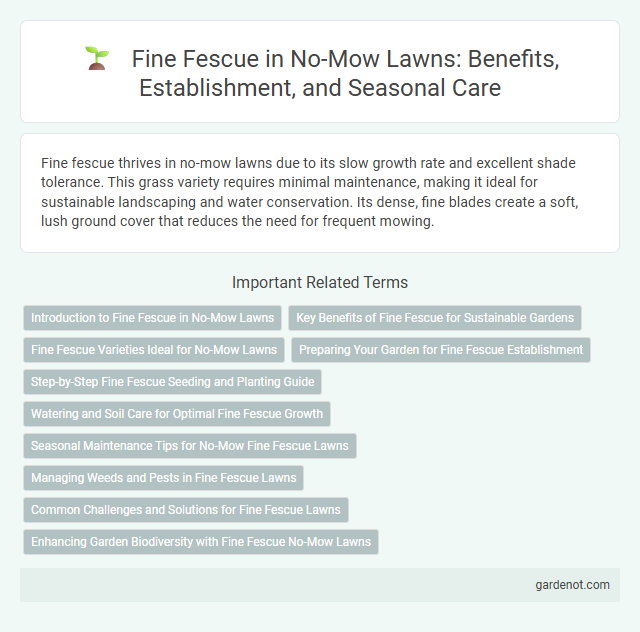Fine fescue thrives in no-mow lawns due to its slow growth rate and excellent shade tolerance. This grass variety requires minimal maintenance, making it ideal for sustainable landscaping and water conservation. Its dense, fine blades create a soft, lush ground cover that reduces the need for frequent mowing.
Introduction to Fine Fescue in No-Mow Lawns
Fine fescue is a preferred grass species for no-mow lawns due to its low growth rate and minimal maintenance requirements. This cool-season grass thrives in shaded areas and tolerates poor soil conditions, making it ideal for eco-friendly landscaping. Its fine texture and drought resistance contribute to a naturally lush, low-maintenance lawn that rarely needs mowing.
Key Benefits of Fine Fescue for Sustainable Gardens
Fine fescue thrives in low-maintenance no-mow lawns, reducing the need for frequent mowing and conserving water through its deep root system. Its tolerance to shade and poor soil conditions makes it ideal for sustainable gardens, promoting biodiversity and minimizing chemical fertilizer use. Fine fescue's natural resistance to pests and diseases supports organic gardening practices, enhancing long-term lawn health and environmental sustainability.
Fine Fescue Varieties Ideal for No-Mow Lawns
Fine fescue varieties such as Creeping Red Fescue, Chewings Fescue, Hard Fescue, and Sheep Fescue are ideal for no-mow lawns due to their low growth rates and drought tolerance. These fine fescues thrive in shaded and poor soil conditions, requiring minimal maintenance compared to traditional turf grasses. Their dense, fine-bladed texture creates a lush, natural appearance without frequent mowing, making them a sustainable choice for eco-friendly landscaping.
Preparing Your Garden for Fine Fescue Establishment
Preparing your garden for fine fescue establishment requires soil testing to ensure a pH level between 5.5 and 6.5, promoting optimal nutrient availability. Clear the area of weeds and debris, then loosen the soil to a depth of at least 4 inches to enhance root penetration and water absorption. Adequate irrigation following seeding maintains consistent moisture critical for fine fescue germination and early growth.
Step-by-Step Fine Fescue Seeding and Planting Guide
Fine fescue thrives in well-drained, acidic to neutral soils with pH levels between 5.5 and 7.0, making it ideal for no-mow lawns. Begin by preparing the soil through aeration and raking to remove debris, then evenly spread fine fescue seeds at a rate of 4-6 pounds per 1,000 square feet for optimal coverage. Water the area lightly but consistently to keep the soil moist until germination, which typically occurs within 7-21 days, and avoid mowing until the grass reaches at least 3 inches in height to encourage deep root development.
Watering and Soil Care for Optimal Fine Fescue Growth
Fine fescue thrives in well-drained, acidic to neutral soil with a pH between 5.5 and 7.0, requiring minimal watering once established due to its drought tolerance. Deep, infrequent watering promotes strong root development, enhancing resilience and reducing disease risk. Maintaining organic-rich soil through occasional aeration and mulch applications supports optimal nutrient absorption and fine fescue growth in no-mow lawn settings.
Seasonal Maintenance Tips for No-Mow Fine Fescue Lawns
Fine fescue thrives with minimal mowing, requiring seasonal maintenance such as early spring dethatching to remove debris and promote air circulation. Fertilize in fall using a low-nitrogen formula to enhance root development and improve drought resistance during summer months. Monitor soil moisture frequently, as fine fescue's deep roots benefit from consistent hydration without overwatering to prevent fungal diseases.
Managing Weeds and Pests in Fine Fescue Lawns
Fine fescue lawns exhibit strong natural resistance to many common weeds and pests due to their dense growth and shade tolerance, reducing the need for chemical interventions. Regular monitoring and maintaining proper mowing heights between 2.5 to 3.5 inches help suppress weed emergence and discourage pest infestations. Incorporating organic mulch and promoting beneficial insects further supports a healthy fine fescue lawn ecosystem by enhancing soil health and naturally controlling pest populations.
Common Challenges and Solutions for Fine Fescue Lawns
Fine fescue lawns often face challenges such as thinning due to drought stress, susceptibility to fungal diseases, and competition from weeds in low-fertility soils. Solutions include maintaining proper soil pH between 5.5 and 6.5, applying slow-release nitrogen fertilizers in early spring, and ensuring adequate irrigation without overwatering to prevent root rot. Regular overseeding and the use of organic mulches can improve turf density and suppress weed growth in no-mow fine fescue landscapes.
Enhancing Garden Biodiversity with Fine Fescue No-Mow Lawns
Fine fescue thrives in shaded, low-maintenance areas, making it an ideal choice for no-mow lawns that support garden biodiversity. Its deep roots promote soil health and water retention while providing a habitat for pollinators and beneficial insects. Incorporating fine fescue into lawn design reduces mowing frequency, lowers carbon emissions, and enhances ecosystem resilience.
Fine fescue Infographic

 gardenot.com
gardenot.com